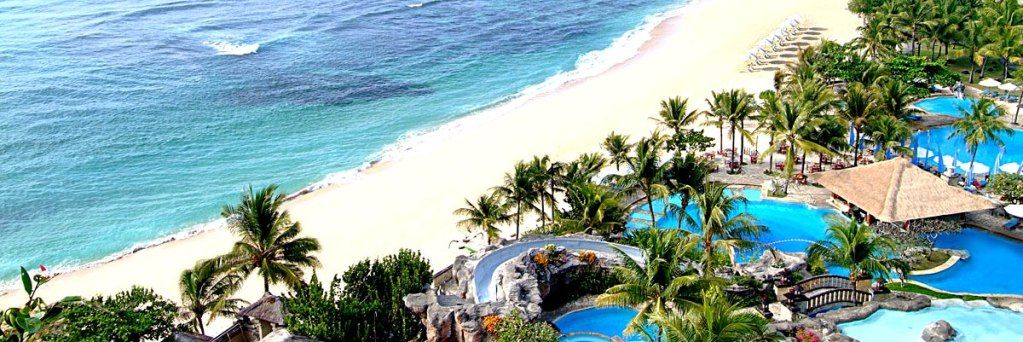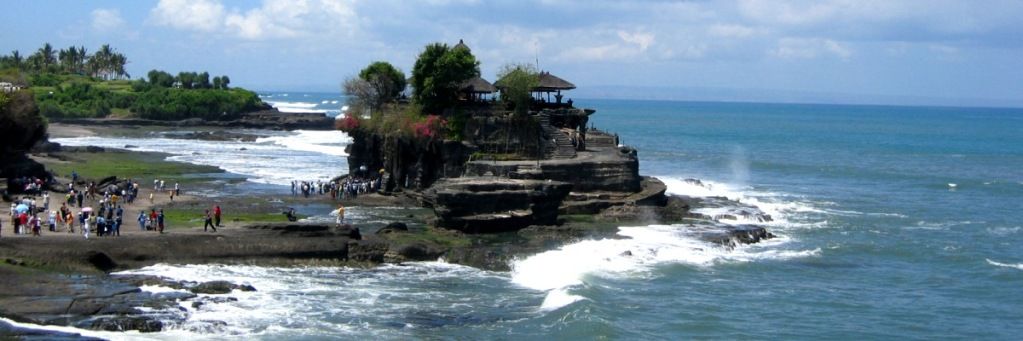WHERE IS BALI?
The island of Bali is part of the Republic of Indonesia and is
located 8 to 9 degrees south of the equator between Java in the West and
Lombok and the rest of the Lesser Sunda Islands (Sumbawa, Flores, Sumba
and Timor) in the East. Flying time to Jakarta is about 1.5 hours, to
Singapore and Perth (Australia) 2.5 and 3 hours, to Hong Kong about 4.5
hours, and to Sydney/Melbourne about 5.5 to 6 hours.
GEOGRAPHY :
The island of Bali has an area of only 5,632 square kilometers
(2,175 square miles) and measures just 55 miles (90 kilometers) along
the north-south axis and less than about 90 miles (140 kilometers) from
East to West. Because of this it's no problem to explore the island on
day tours. You can go wherever you want on the island and return to your
hotel or villa in the evening.
Located only two kilometers east of Jawa, Bali's climate, flora
and fauna are quite similar to its much larger neighbour. The island is
famous for its beautiful landscape. A chain of six volcanoes, between
1,350 meters and 3,014 meters high, stretches from west to east. There
are lush tropical forests, pristine crater lakes, fast flowing rivers
and deep ravines, picturesque rice terraces, and fertile vegetable and
fruit gardens. The beaches in the South consist of white sand, beaches
in other parts of the island are covered with gray or black volcanic
sand.
FLORA:
The wide variety of tropical plants is surprising. You'll see
huge banyan trees in villages and temple grounds, tamarind trees in the
North, clove trees in the highlands, acacia trees, flame trees, and
mangroves in the South. In Bali grow a dozen species of coconut palms
and even more varieties of bamboo. And there are flowers, flowers everywhere. You'll see (and
smell the fragrance of) hibiscus, bougainvillea, jasmine, and water
lilies. Magnolia, frangipani, and a variety of orchids are found in many
front yards and gardens, along roads, and in temple grounds. Flowers
are also used as decorations in temples, on statues, as offerings for
the gods, and during prayers. Dancers wear blossoms in their crowns, and
even the flower behind the ear of your waitress seems natural in Bali.
FAUNA :
Elephants and tigers don't exist any more in Bali since early
this century. Wildlife, however, includes various species of monkeys,
civets, barking deer and mouse deer, and 300 species of birds including
wild fowl, dollar birds, blue kingfishers, sea eagles, sandpipers, white
herons and egrets, cuckoos, wood swallows, sparrows, and starlings. You
can watch schools of dolphins near Lovina, Candi Dasa, and Padangbai.
Divers will see many colorful coral fish and small reef fish, moray
eels, and plankton eating whale sharks as well as crustaceans, sponges,
and colorful coral along the east coast and around Menjangan Island near
Gilimanuk.
CLIMATE :
You can expect pleasant day temperatures between 20 to 33
degrees Celsius or 68 to 93 degrees Fahrenheit year-round. From December
to March, the West monsoon can bring heavy showers and high humidity,
but usually days are sunny and the rains start during the night and pass
quickly. From June to September the humidity is low, and it can be
quite cool in the evenings. During this time of the year, you'll have
hardly any rain in the coastal areas. Even when it rains in most parts of Bali you can often enjoy
sunny days on the "Bukit", the hill south of Jimbaran Beach. On the
other hand, in Ubud and the mountains you must expect cloudy skies and
showers throughout the year (this is why the international weather
reports for "Denpasar" or "Bali" mention showers and rain storms during
all times of the year). In higher regions such as in Bedugul or
Kintamani you'll also need either a sweater or jacket after the sun
sets.
POPULATION :
Bali's population has grown to over 3 million people the
overwhelming majority of which are Hindus. However, the number of
Muslims is steadily increasing through immigration of people from Java,
Lombok and other areas of Indonesia who seek work in Bali. Most people live in the coastal areas in the South, and the
island's largest town and administrative center is fast growing Denpasar
with a population of now over 370,000. The villages between the town of
Ubud and Denpasar, Kuta (including Jimbaran, Tuban, and Legian,
Seminyak, Basangkasa, etc), Sanur, and Nusa Dua are spreading rapidly in
all directions, and before long the whole area from Ubud in the North
to Sanur in the East, Berawa/Canggu in the West, and Nusa Dua in the
South will be urbanized.
ECONOMY :
This southern part of Bali is where most jobs are to be found,
either in the hotel and tourist industry, the textile and garment
industry, and in many small scale and home industries producing
handicrafts and souvenirs. Textiles, garments, and handicrafts have
become the backbone of Bali's economy providing 300,000 jobs, and
exports have been increasing by around 15% per year to over US$400
million. Textiles and garments contribute about 45%, and wood products
including statues, furniture and other handicrafts 22% to the province's
total income from exports. Silver work is ranked third (4.65%) with
5,000 workers employed. Main buyers are the US and Europe with 38% each,
and Japan with 9%. Important agricultural products besides rice are tea, coffee,
tobacco, cacao, copra, vanilla, soy beans, chilies, fruit, and vegetable
(there are now even vineyards near the northwest coast). Bali's fishing
industry and seaweed farming provide other products which are important
exports. The new free-trade regulations will create some problems for
Bali's exporters as they do not allow to employ children. Most children
here work for their parents, and this is part of the process of
acquiring professional skills and kind of an informal education which
has been very important in the Balinese society for centuries.
WHAT MAKES BALI SO SPECIAL :
There is the combination of the friendly people, the natural
attractions, the great variety of things to see and do, the year-round
pleasant climate, and the absence of security problems. And then there
is Bali's special "magic", which is difficult to explain. As soon as you step off the plane you might sense the
difference. In the villages you'll notice the quietness and wisdom in
old people's faces, and the interest and respect in the young's. Old men
sit at the road side caressing their fighting cocks. Beautifully
dressed women walk proudly through rice fields and forests carrying
offerings on their heads to the next temple. There is the smell of
flowers, and in the distance you hear the sound of gamelan music. Gods and spirits have been an important part of Bali's daily
life for hundreds of years. Gunung Agung – Bali's holy mountain – is
internationally regarded as one of the eight "Chakra" points of the
world. This may be more than an coincident. Watch out, the moment you
feel the magic of this island, you're addicted for the rest of your
life.


















